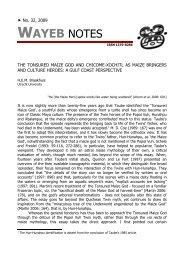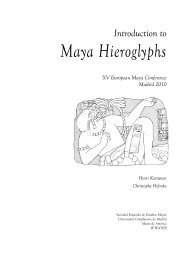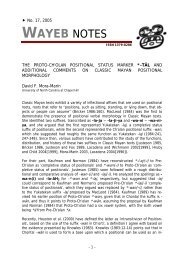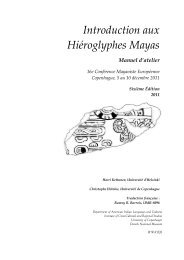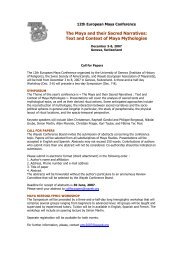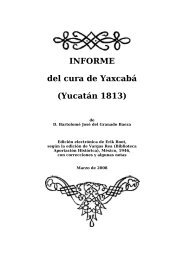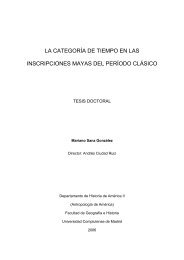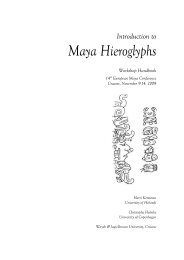Introduction to Maya Hieroglyphs - Wayeb
Introduction to Maya Hieroglyphs - Wayeb
Introduction to Maya Hieroglyphs - Wayeb
Create successful ePaper yourself
Turn your PDF publications into a flip-book with our unique Google optimized e-Paper software.
Kettunen & Helmke 2011<br />
The Writing System<br />
homophones:<br />
• buy ⎯ by ⎯ bye<br />
• cite ⎯ sight ⎯ site<br />
• right ⎯ rite ⎯ wright ⎯ write<br />
• who’s ⎯ whose ⎯ hoos ⎯ hoose (verminous bronchitis of cattle)<br />
• weather ⎯ whether ⎯ wether (a castrated male sheep)<br />
12. NUMBER OF KNOWN HIEROGLYPHS<br />
One of the most common questions <strong>to</strong> epigraphers concerns the number or percentage of deciphered hieroglyphs.<br />
The answer is somewhat more complex than one might expect. First of all, we have <strong>to</strong> consider what we mean by<br />
“deciphered”. If we were <strong>to</strong> calculate the number of hieroglyphs whose phonetic value we know, the <strong>to</strong>tal would<br />
be around 80 percent. On the other hand, if we were <strong>to</strong> estimate the number of signs whose meaning is securely<br />
attested, the number is considerably lower, around 60 percent. The problem lies in the fact that there are a<br />
number of hieroglyphs in the script whose:<br />
• phonetic value is known but the meaning escapes decipherment (more commonly in the case of fully<br />
phonetically written signs)<br />
• meaning is known but the phonetic value is uncertain, vague, or not known at all<br />
• phonetic value and meaning are only partly known (for example a word standing for a ritual that was<br />
performed before adulthood)<br />
• phonetic value and meaning are only partially known, or not at all<br />
phonetic value:<br />
yes<br />
no<br />
meaning:<br />
yes completely deciphered gray area<br />
no gray area completely undeciphered<br />
Yet another problem is that of what we mean by saying that the meaning of a particular hieroglyph is known. The<br />
meaning of a single hieroglyph or a set of hieroglyphs in a sentence might be known 35 but the profound<br />
contextual significance and implications of the word and sentences need <strong>to</strong> be checked against all other possible<br />
sources, such as ethnology, archaeology, iconography, and present day manifestations of the <strong>Maya</strong> culture(s). In a<br />
word, <strong>Maya</strong> epigraphy at its best is a multi- and interdisciplinary branch of learning heavily based on linguistics<br />
but taking in<strong>to</strong> account all possible sources and academic disciplines.<br />
On the whole, in all its complexity, the <strong>Maya</strong> hieroglyphic system is merely one way <strong>to</strong> make a spoken language<br />
visible, and <strong>to</strong> quote the late Yuri Knorozov: “I believe that anything invented by humans can be deciphered by<br />
humans” (Kettunen 1998a).<br />
35<br />
A further distinction is made between a gloss and a translation: a gloss provides a reading for an isolated hieroglyph whereas an accurate<br />
translation takes in<strong>to</strong> account the syntax and semantics in the sentence.<br />
22/154



